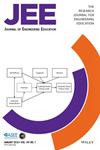Engineers, figuring it out: Collaborative learning in cultural worlds
Abstract
Background
Although open-ended projects are common in the first and final years of US engineering programs, middle-year courses tend to utilize simpler highly constrained problems. Such problems can elicit knowledge and social practices typical of school activity (“School World”), with limited applicability in real engineering work (“Engineering World”). They can also result in inequitable participation in groups.
Purpose
We investigate whether a single-session, complex studio task can promote equitable disciplinary engagement in the middle years, where time is limited and students' engineering knowledge needs to be developed. We ask whether and how the task is taken up by teams “thinking and acting like students” versus “thinking and acting like engineers.”
Design/Method
This microgenetic laboratory study analyzes video data of three student teams completing a realistic complex task.
Results
Teams initially used “School World” strategies and social arrangements, but eventually the task demands and facilitator framing shifted activity to “Engineering World.” We found within-team, between-world differences in reasoning, tool use, and social practices. Examination of shifts from School World to Engineering World pointed to the importance of task framing, material tools, peer interaction, and facilitator support.
Conclusions
Activity can shift to the disciplinary social and knowledge practices of engineering in a single task, expanding opportunities to learn those practices and promoting more equitable interactions. Instructors should seek to support disciplinary practices while preserving students' authority to make decisions. Future research should explore the impact of a steady diet of these kinds of studios in the middle years.

 求助内容:
求助内容: 应助结果提醒方式:
应助结果提醒方式:


